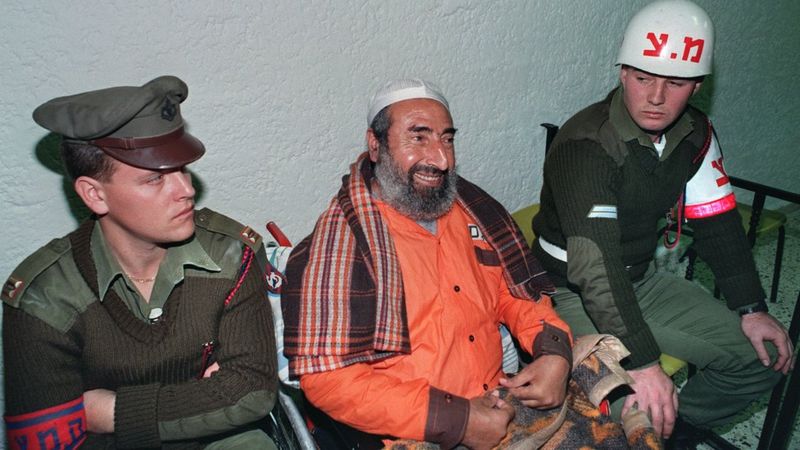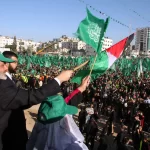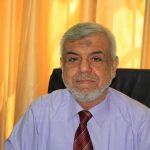The defeat of June 1967 represented the beginning of the “awakening” of the Islamic movement, and helped the return of the “Muslim Brotherhood “To the political scene in Egypt, after Anwar Sadat assumed power in May 1971, due to the growing role of the “group” in the Gaza Strip, which had chosen Sheikh Ahmed Yassin to lead its organization in the Gaza Strip in 1968, he became active in building the organization’s body, In 1973, he founded the first nucleus of the “Islamic Complex,” which consisted of a mosque, a medical clinic, a kindergarten, and a zakat committee. In 1979, the number of its members reached about 2,000, after obtaining an official license from the Israeli occupation authorities, which they thought would ignore them. On the social activity of the “Islamists” that will contribute to weakening the positions of the Palestine Liberation Organization. Sheikh Ahmed Yassin also founded the “Islamic Society” in 1976, and contributed to the founding of “Islamic University In the year 1978. The growing role of the “group” during that period was not limited to the Gaza Strip, but also extended to the occupied West Bank, with the increasing financial support that the “Muslim Brotherhood” began to receive from multiple Arab parties, especially after the great victory it achieved. Lists of the Palestine Liberation Organization, which included a number of communists, in the municipal elections that took place in the West Bank in April 1976.
Establishment
Since the early 1980s, the Muslim Brotherhood has been playing a noticeable political role, especially within Palestinian universities, focusing its activities primarily on confronting the secular approach of the Palestine Liberation Organization. While she continued to consider that the stage “is still the stage of preparing and educating the Islamic generation that will lead the process of transforming society into an Islamic society as a prelude to declaring jihad.” These positions of the leadership of the Muslim Brotherhood contributed to creating division among its ranks and encouraged the formation of the “Islamic Jihad Movement in Palestine,” which adopted a strategy of armed struggle.
And I have an outbreakuprising In December 1987, in order to maintain and strengthen its influence, the leadership of the Muslim Brotherhood had no choice but to move from “traditional Islam” to “jihadist Islam,” as seven of its leaders met in Gaza City, headed by Sheikh Ahmed Yassin. On December 9, 1987, they agreed to establish an organizational framework that would enable the “group” to wage jihad against the occupation, and the name “Islamic Resistance Movement” (Hamas) appeared in its first statement, which was distributed on the 14th of the same month.
From the Gaza Strip, Hamas extended its activity to the West Bank in January 1988. The movement initially participated in street confrontations and strikes, then it began to emerge, through its independent activities, as a competing and parallel framework to the Palestine Liberation Organization. It engaged in armed actions against Israeli targets through its military wing, which initially bore the name “Palestinian Mujahideen,” led by Salah Shehadeh, then developed to bear, since May 1990, the name “Izz al-Din al-Qassam Brigades,” whose most prominent leaders were Bashir Hammad, Imad Aql, Yahya Ayyash, and Muhammad al-Deif.
At the level of its organizational structure, such as:Consultative Council The General Assembly is the highest organizational body within the Hamas movement, which elects the political office and its president. The movement practices “shura” within its organizational and institutional structures, as it holds periodic elections every four years to choose the movement’s leaders in all sectors.
Hamas’s political orientations
On August 18, 1988, the Hamas movement distributed its charter, which defined the movement’s starting points and goals. It affirmed that Hamas is “a wing of the Muslim Brotherhood in Palestine,” “takes Islam as a way of life,” and considers the land of Palestine “a land of endowment.” My Islamic commitment to the generations of Muslims until the Day of Resurrection, it is not permissible to neglect it or any part of it,” and that the liberation of Palestine is “an individual obligation for every Muslim wherever he may be.” When referring to the “enemy” camp, Hamas did not distinguish, in its charter, between “Zionism “And “the Jews”, but rather focused on the latter as “they worked to collect enormous and influential material wealth, which they harnessed to achieve their dream.” After the movement indicated, in its charter, that it exchanges respect with the national movements in the Palestinian arena… and extends its support to As long as it does not give its allegiance to the communist East or the Crusader West, and sees the Palestine Liberation Organization as “the closest confidant to the Islamic Resistance Movement,” she stressed that the idea of the secular state adopted by the PLO is “completely contradictory to the religious idea.”
The leadership of the Palestine Liberation Organization tried to accommodate the Hamas movement when it was founded, and in 1988 it was offered to join the Palestinian National Council, but Hamas refused to participate in the organization’s bodies. On the eve of the nineteenth session of the Palestinian National Council in mid-November 1988 and its adoption of the Palestinian “Peace Initiative,” the position of the “Hamas” movement, rejecting political solutions, emerged, as it affirmed in an appeal it addressed on the 10th of that month to members of the Palestinian National Council that the battle “ With the Zionists, it is not a battle over dividing borders or a dispute over a piece of land, but rather a battle for existence and destiny. Then, in a statement issued on October 7, 1991, the movement opposed the approval of the majority of members of the twentieth session of the National Council for the PLO’s participation in the “peace” conference inMadrid , considering that any Palestinian delegation formed on the basis of the decisions of that session “is an illegitimate delegation and does not represent the Palestinian people.” On the 24th of the same month, the Hamas movement participated with nine Palestinian factions in issuing a statement calling on the leadership of the PLO to retract its decision to participate in the war.Madrid Conference “Aiming to liquidate our cause and Jerusalem.” Then, it strongly opposed the “Oslo Accords,” and appreciated, in the words of Sheikh Ahmed Yassin, that those who signed the “recognition of the State of Israel” thereby surrendered “all that it usurped of our land, our heritage, our sanctities, and our civilization.”
Hamas armed activity
The Hamas movement’s military operations, under the name “Palestinian Mujahideen”, began in the spring of 1988, which prompted the Israeli authorities to launch a massive repressive campaign against the movement and its military apparatus in May 1989, during which Sheikh Ahmed Yassin and a large number of its leaders and cadres were arrested. The Israeli military courts sentenced Sheikh Ahmed Yassin to life imprisonment plus another fifteen years, and he was only released on October 1, 1997 in an exchange that took place between Jordan and Israel, when the Jordanian authorities handed over to the Israeli authorities two Mossad agents. They were arrested following the failed attempt to assassinate the head of the Hamas political bureau, Khaled Meshal, in the capital, Amman, in exchange for the release of Sheikh Ahmed Yassin.
In December 1992, Izz al-Din al-Qassam Brigades fighters carried out the capture and killing of the Israeli soldier Nissim Toledano, to which the Israeli occupation authorities responded with a new campaign of arrests within the ranks of the movement, and the deportation of 415 of its activists, and activists of the “Islamic Jihad” movement to “Meadow of Flowers” in southern Lebanon, until Israel responded to pressure from the United States, which was concerned with the continuation of Arab-Israeli negotiations. In the years 1993 and 1994, the movement’s military activity escalated and took a more violent turn, embodied in carrying out a series of suicide operations in the heart of Israel, culminating in a series of bus bombings in Jerusalem, Ashkelon, and Tel Aviv in February and March 1996, in response to the forces’ Israel assassinated the leader of the Izz al-Din al-Qassam Brigades, Yahya Ayyash, on January 5, 1996.
Hamas and the Palestinian National Authority
The Hamas movement continued its military activity even after the establishment of the Palestinian Authority in 1994, while refraining from entering into an open conflict with it . While the authority began to tighten its grip on the movement more and more, in response to its military activity. On the eve of the elections that took place in January 1996, to electParliment The Hamas movement announced its boycott of the elections, because “they are taking place under the umbrella of the Oslo Accords.” During the years 1997 and 1998, the Palestinian Authority continued to restrict the movement’s military activity, and in April 1998, it arrested a number of its leaders, including Dr. Abdel Aziz Al-Rantisi. He served as the movement’s official spokesman.
When the second intifada broke out in late September 2000, there was a relative improvement in relations between the Palestinian Authority and the Fatah movement, on the one hand, and the Hamas movement, on the other hand. However, Hamas was subjected, especially after the events of September 11, 2001, to a massive Israeli and Western targeting campaign, under the pretext of being a “terrorist” movement. The Israeli occupation authorities took a decision to liquidate a number of the movement’s most prominent leaders. Between 2001 and 2003, they assassinated Jamal Salim and Jamal Mansour. Mahmoud Abu Hanoud, Salah Shehadeh, Ibrahim Maqadmeh, and Ismail Abu Shanab. At dawn on March 22, 2004, Israel assassinated Sheikh Ahmed Yassin and seven of his companions in a military operation that included an Apache helicopter firing three missiles at him as he was leaving in his wheelchair from the Islamic Complex Mosque in the Al-Sabra neighborhood in the Gaza Strip. Two of his sons were injured in the operation. After the martyrdom of Sheikh Ahmed Yassin, the Hamas movement pledged allegiance to Dr. Abdel Aziz Al-Rantisi, his successor in the leadership of the movement. But less than a month had passed since he occupied this position, when an Israeli helicopter fired three missiles at his car in the Gaza Strip, on April 17, 2004, killing him and two of his companions.
Control of the Gaza Strip
Hamas’ movement towards integration into the Palestinian political system emerged in 2004, when it participated in the local elections called for by Yasser Arafat on May 5 of that year after they had been postponed since 1996, in which the movement achieved good results. Then came the announcement by the government of Ariel Sharon of its intention to unilaterally withdraw from the Gaza Strip, encouraging Hamas leaders to take new steps on the path to this integration, which became a reality after the departure of Yasser Arafat, in November 2004, and the election of Mahmoud Abbas to replace him as president of the Palestinian Authority. And the Palestine Liberation Organization, in January 2005. It was only a few weeks after his election that the new president succeeded, after a series of meetings held in Cairo, in reaching an understanding with the leadership of the Hamas movement, and with the leaders of the other Palestinian factions, which stipulated the commitment of the armed factions By refraining from carrying out military operations until the end of 2005, holding legislative elections, and beginning talks to include the Hamas and Islamic Jihad movements into the Palestine Liberation Organization.
In the Legislative Council elections, which took place in January 2006, the Hamas movement won the majority of seats in the Council, which led to a dual polarization in the Palestinian arena, which began to deepen, especially in the Gaza Strip, following the departure of the last Israeli soldier from the Strip on September 12. 2005, and a state of security chaos emerged, and armed clashes occurred repeatedly between members of the Palestinian police and Hamas fighters, which turned into a comprehensive conflict, which ended, in mid-June 2007, with Hamas imposing its control by military force over the Gaza Strip, which led to An administrative and political division occurred between the West Bank and the Gaza Strip.
Hamas is in power
After the Hamas movement took control of the Gaza Strip, several attempts were made, since late February 2009, to end the Palestinian-Palestinian division, all of which failed until the beginning of 2020. On the other hand, the Gaza Strip, since it came under the control of the Hamas movement, has been subjected to A stifling siege imposed by Israel caused a significant deterioration in the living conditions of its residents. Israel also launched four major wars on the Gaza Strip between the end of 2008 and the spring of 2021, which led to the martyrdom of thousands of Palestinians, the fall of tens of thousands of wounded and disabled people, and the destruction of thousands of homes, workshops, and factories. . After taking control of the Gaza Strip, the Hamas movement stopped bombing or “martyrdom” operations, and began resorting, in response to Israeli attacks, to launching rockets smuggled through tunnels into the Gaza Strip or manufactured locally. The latter has witnessed significant development in terms of quality and quantity, as was demonstrated during the confrontation in May 2021 with Israel.
The new Hamas document and its new leadership
The Hamas movement announced on the evening of May 1, 2017 from Doha, through the head of its political bureau at the time, Khaled Meshaal, a document A new policy, under the name “Hamas Movement’s General Principles and Policies Document,” adopted the goal of establishing an independent Palestinian state, as it stated that “Hamas considers the establishment of an independent, fully sovereign Palestinian state, with Jerusalem as its capital, on the lines of June 4, 1967, with the return of refugees and displaced persons to Their homes from which they were expelled are a common national consensus formula, which “does not mean at all recognition of the Zionist entity, nor waiver of any Palestinian rights.” In this document, the movement also severed its declared connection with the “Muslim Brotherhood” group, as it was stated in the movement’s definition that “The Islamic Resistance Movement ‘Hamas’ is a Palestinian Islamic national liberation and resistance movement, whose goal is to liberate Palestine and confront the Zionist project. Its reference is Islam in its starting points, goals, and means.” This document also distinguished between Jews and Zionism, as it used the word “Zionists” when it affirmed that “the Zionist project is a racist, aggressive, replacementist, expansionist project, based on usurping the rights of others, and hostile to the Palestinian people and their aspirations for freedom, liberation, return, and self-determination; and that the entity “The Israeli is the tool of the Zionist project and its aggressive base.”
One of the goals of the Hamas movement, in issuing this document, was to serve as a “passport” for it towards international recognition, but its new political discourse left little repercussions on the international scene .
On May 6, 2017, the results of the elections held by the Hamas movement in the Gaza Strip, the West Bank, inside prisons, and outside Palestine were announced, which resulted in the election of 45 members of the General Shura Council, who elected 19 members of the Political Bureau for a period of 4 years. They elected Ismail Haniyeh as head of this office, succeeding Khaled Meshaal, who had held this position since 1996. Before that, the movement had elected Yahya Al-Sinwar, its organizing officer in the Gaza Strip. In April 2021, the Hamas movement re-elected Ismail Haniyeh as head of its political bureau, and Yahya al-Sinwar was responsible for its organization in the Gaza Strip. It also elected Salah Al-Arouri as responsible for its organization in the West Bank, and Khaled Mishal as responsible for the movement abroad.
Hamas’s foreign relations
Since the early 1990s, Syria has embraced members of the leadership of the Hamas movement residing outside Palestine and supported the movement, which also relied on significant political and material support it received from Iran, and established close alliance relations with the Lebanese Hezbollah, until its relations with these allies worsened after Hamas’s support for the popular movement that has been taking place in Syria since March 2011, and the participation of groups close to it in the activity of the Syrian armed opposition. The movement subsequently transferred its leadership center abroad to Qatar, and strengthened its historical alliance relations withTürkiye . However, the movement’s relations began to witness a significant improvement with both Iran and Hezbollah after 2017, thanks to the efforts made in particular by Yahya Sinwar and the leadership of the Izz al-Din al-Qassam Brigades, which realizes that the military, financial, and technical support provided by Iran cannot replace it. As for the Hamas movement’s relations with the Syrian leadership, they remained severed, and the efforts made to restore them have not succeeded so far.
On the other hand, Hamas’ relations with Egypt witnessed significant development during the era of President Abdel Fattah El-Sisi, as the Egyptian authorities began to play the role of the first mediator between them and Israel, a role that was clearly evident after the war launched by Israel on the Gaza Strip in May 2021. The Egyptian authorities played an active role in reaching a ceasefire, then they began participating in reconstruction projects in the Gaza Strip, and they are making unremitting efforts to reach a long-term truce between the Israeli government and the Hamas movement.


